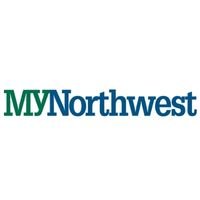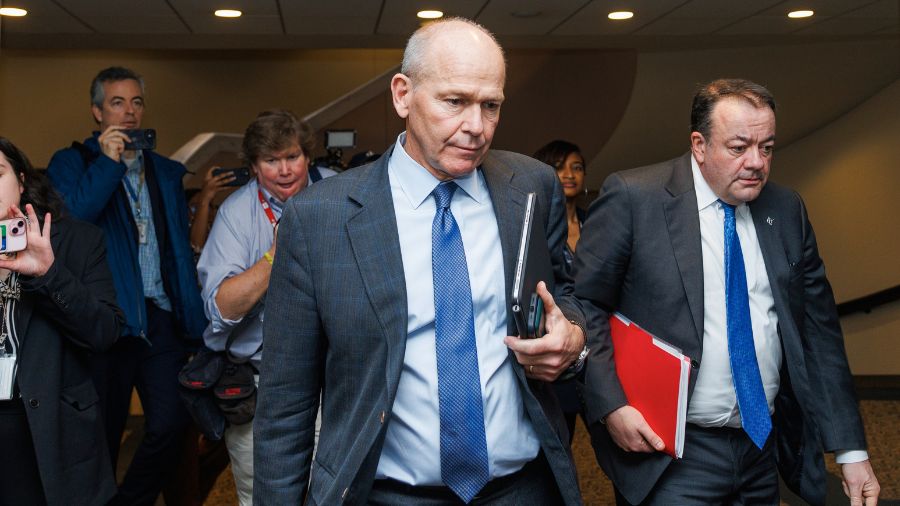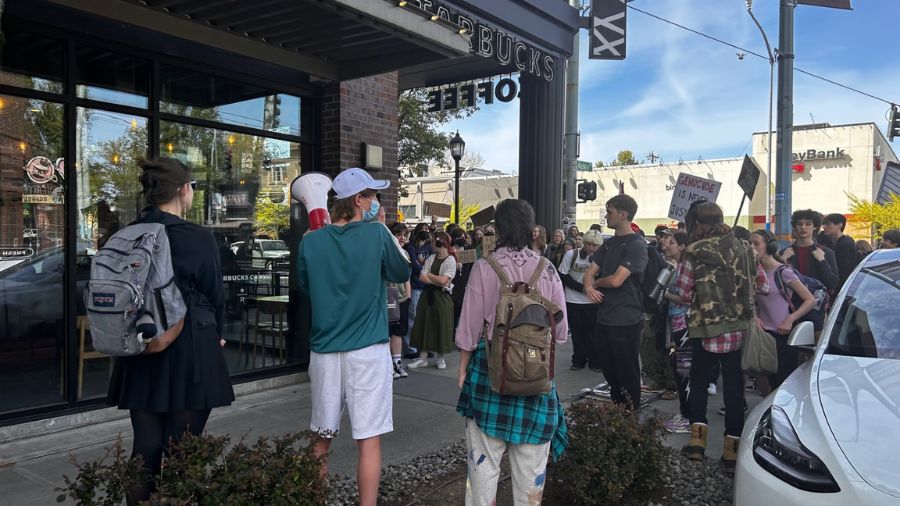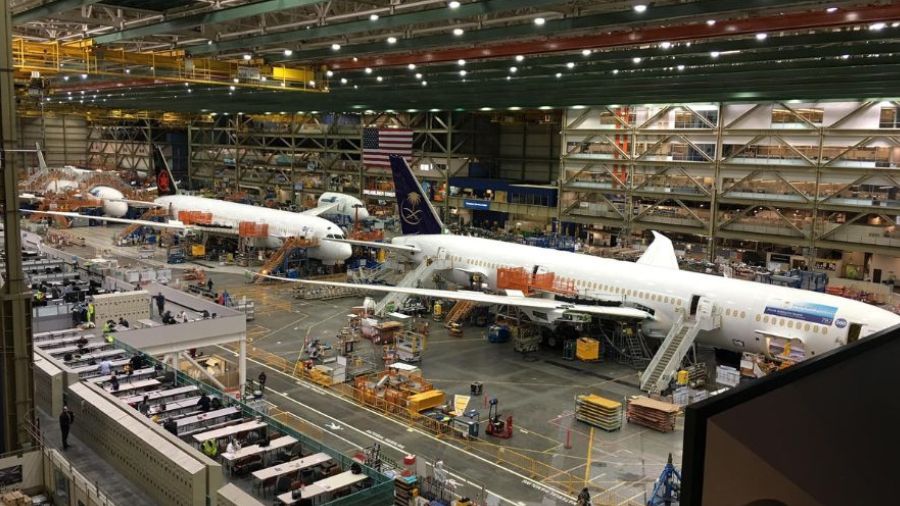A much different Seattle for first presidential visit
Oct 10, 2013, 4:41 PM | Updated: Oct 11, 2013, 10:08 am
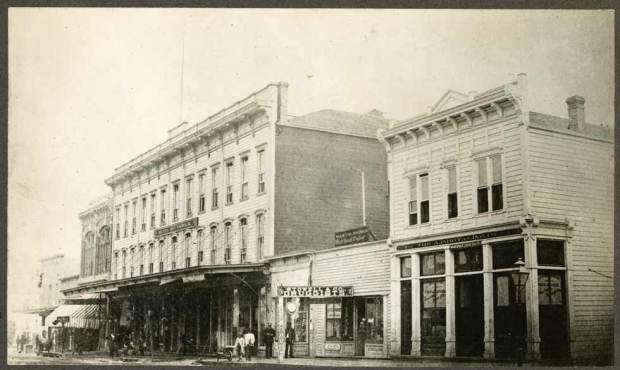
Squire's Opera House on Commercial Street between Washington Street and Main Street. Built 1876. Destroyed by fire June 6, 1889. 1880. (Courtesy of The Seattle Public Library - shp_5072)
(Courtesy of The Seattle Public Library - shp_5072)
Within the boundaries of Cougar Mountain Regional Wildland Park south of Bellevue, the 19th century coal mining community of Newcastle is a ghost town.
On First Avenue, between Main and Washington south of downtown Seattle, Squire’s Opera House is now just a faded photograph and forgotten victim of the 1889 Great Seattle Fire. The “sinking ship” parking garage across the street from the Smith Tower was once site of the Occidental Hotel, which was also lost in the fire. Somewhere on the muddy bottom of Lake Union rests the rusty hardware of what used to be the grand Mosquito Fleet steamer “George E. Starr,” abandoned and sunk in the 1920s.
What these places and things have in common, in addition to being long-gone, is their role in the visit of President Rutherford B. Hayes to Seattle on October 11, 1880.
In the nearly five years that he’s been in office, President Obama has visited the Seattle area multiple times. The ease with which Commanders-in-Chief can cross the continent, thanks to that Everett, WA built Boeing 747, makes even a one-day cross-country trip somewhat routine.
When the first president to visit the Pacific Northwest made his way here more than 130 years ago, travel was a bit more involved. It was also slower and dustier, too.
President Hayes spent much of September 1880 traveling by train, horse and boat on what would come to be called his “Great Western Tour.” Hayes traveled from his native Ohio to California and back, becoming the first American president to cross the Rocky Mountains.
On September 27, President Hayes arrived via horse-drawn coach in Ashland, Oregon just north of the California border. The president and his entourage, which included his wife Lucy, Civil War General William Tecumseh Sherman, and Secretary of War Alexander Ramsey, had left San Francisco more than two weeks earlier via an overland route. In Ashland, Hayes made a short speech, telling the assembled crowd, “We are wearied and covered with the dust of travel. We were advised to go to Portland by water; we were told ladies could not travel by the stage route, but General Sherman said: ‘Let us come this way,’ and we are glad we came, ladies and all.”
On October 1, Hayes reached rapidly growing Portland, which was then the de facto capital of the Pacific Northwest and a bustling metropolis. “I must confess my amazement and surprise,” the president told a large audience gathered at the Mechanics Pavilion, “at seeing your churches, schoolhouses, stores and dwellings … and at the thought that you had accomplished what had taken other cities one hundred years in less than a quarter of a century.”
President Hayes then traveled west to Forest Grove, Oregon and east to Walla Walla. Walla Walla was briefly the largest city in what’s now Washington (and what was then Washington Territory), and had even vied with Olympia to become the capitol. Leaving Walla Walla, Hayes returned to Portland, and on Saturday, October 9 the party left there by the steamboat, heading north on the Willamette River and crossing the Columbia to land at Kalama, Washington Territory. From there, the party traveled by train to Tenino, then via narrow gauge railway to Tumwater and Olympia.
In Olympia, the New York Times reported that the, “Mayor and prominent citizens greeted the party. The streets along the line of march were decorated with flags, and the crowds cheered as the party passed. In response to loud calls from the crowd in front of the hotel, the president spoke briefly. Secretary Ramsey and General Sherman also made short speeches. Mrs. Hayes appeared in answer to repeated calls, and bowed. At 6:30 o’clock a reception was held in the Town Hall.”
On Sunday morning, President Hayes “took a walk about town” and, with Mrs. Hayes, attended services at the Methodist Church. In the afternoon, they had lunch at the home of Washington Territorial Governor Elisha Ferry. The New York Times reported that “drives to various points of interest followed” via horse-drawn coach.
On Monday, October 11, the party left Olympia by the steamer “George E. Starr.” Another story appeared in the New York Times, this time bylined inaccurately from “New Tacoma, Wyoming” describing the voyage and brief stops made at Steilacoom and Tacoma before the party arrived in Seattle in the early afternoon. In Seattle, the president stayed at the Occidental Hotel, where he gave a speech from the balcony before taking a trip by rail to Newcastle and Renton, and then returning to the city.
According to author and historian J. Willis Sayre, “That night was the most exciting in Seattle’s history since the Indian battle. Hotels, stores and homes were ablaze with candles, lamps and gas; the university was lighted from top to bottom, a dazzling beacon far above the business center. Bonfires were lighted in Occidental Square, the band played industriously and endless throngs milled the streets. At a reception in Squire’s Opera House the president shook hands with 2,000 persons.”
Back in 1880, Seattle’s population was 3,533.
The next day, the entourage left Seattle by steamer, crossing Puget Sound to visit Port Gamble, Port Blakely and Port Townsend. As they neared Port Townsend, “a steamboat came alongside with the Committee of Reception on board. Salutes were fired from the battery. Fully 1,500 people were assembled on the dock, and as the steamer came along, repeated cheers were given for the president.”
After Port Townsend, President Hayes traveled to Tacoma and Astoria before returning to Ohio in time for the 1880 election in early November. The 1876 election had been a contentious one, and as part of a compromise, Hayes had vowed to serve only one term. In 1880, he threw his support behind fellow Ohio Republican and ultimate victor James A. Garfield.

